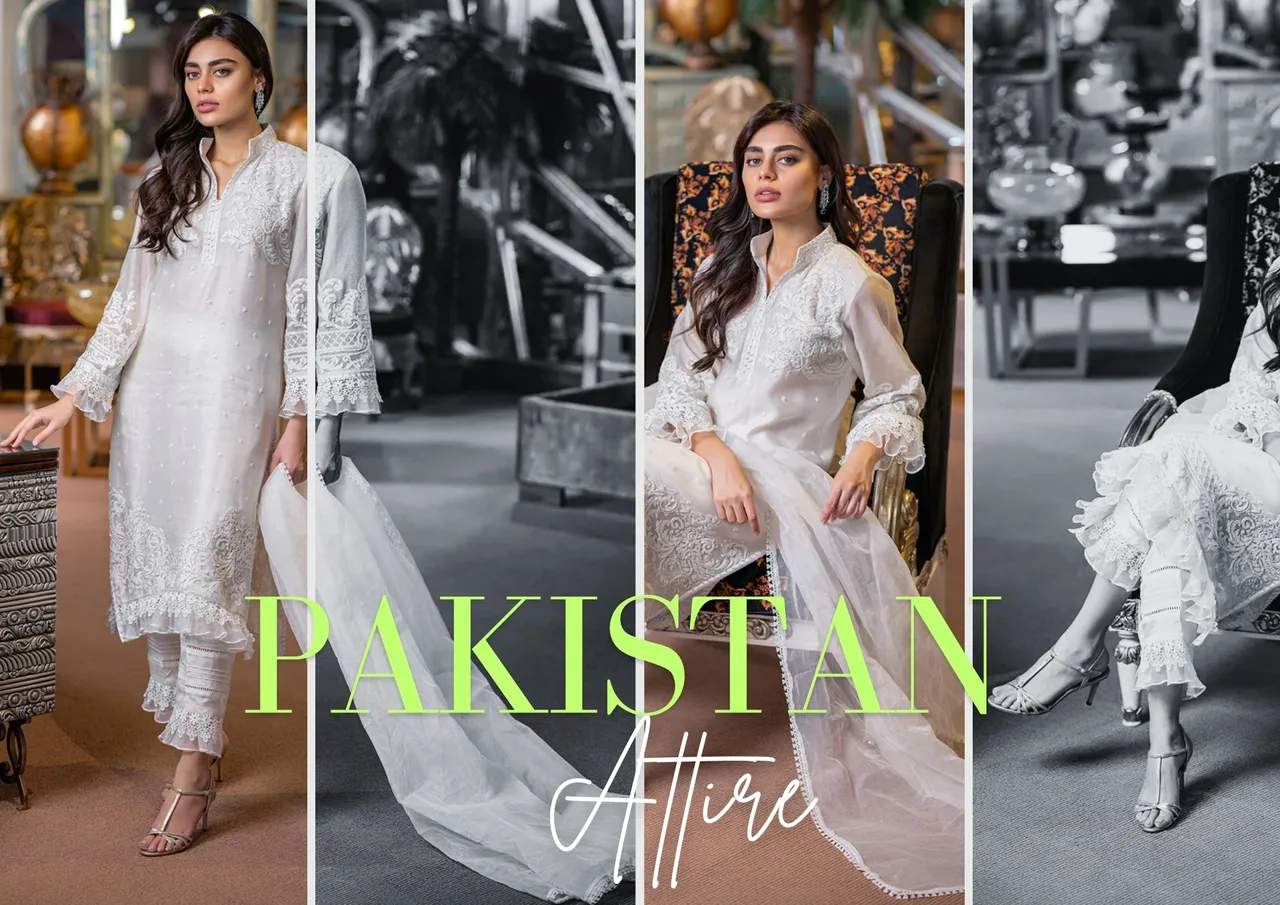Understanding the Attire Enigma in Pakistan’s Women
Hajra Sumaira Imran

The Art of Adornment
The dress code of a person is a reflection of one’s personality. Each country has its respective dress code for both genders. Fashion trends and designs have evolved with time, carrying with them the spirit of the era. In the last two centuries and then the transition into the twenty-first century, history took a major turn. Ideologies were destroyed and evolved with an impressionable impact on the physical attire.
If the focus is put on South Asia, specifically Pakistan then the partition can be a distinctive line for studying the dress code of women. Before partition, the culture of the subcontinent had immense diversity. The Mughal era had its specifications with embroidered dresses such as saris, and gowns. When the British came, along came the Western attire but the women were stuck to their tradition. Men on the other hand, especially upper-class men were seen in crisp suits but were also seen in sherwani, kurta, angarkha, lungi, etc.
After 1947, tribal and princely states were annexed and their rule was over. However, the traditional attire was carried distinguishing each culture which were known as Punjabi, Balochi, Sindhi, Kashmiri, Pakhtun, etc. There are also many subcultures such as Kalasha, Balti, Kalasha, Seraiki, and Hazara. The patterns of their design add to the multicultural beauty of the women of Pakistan. Balochi have Doch, Sindhis have ajrak, Seraikis have ajrak, chitrali pakol, etc.
In urban areas, women were seen in Saris with sleeveless blouses, shalwar kameez with dupattas in their necks, or swaying on shoulders. In rural or tribal areas, the women had a big chaddar with them and stuck to lehengas and kurtis. But when the religious sentiments were evoked in Pakistani identity and it was limited to religious attire, things began to change. The Islamization projects and the Afghan war brought the burqa to Pakistan. It diminished the vibrancy of women to a monotone black attire. It was preached that women are objects of desire and sexual appeal hence they should be clad in a loose piece of clothing so that men can’t be strayed from the right path.
It was not that women were immodest or wore revealing clothes, although it is a personal choice and must not be morally policed. Shalwar kameez was common with distinct varieties such as gararas and shararas. The head scarf was not made a big deal until it was imposed by men on women to cover their heads. The influence of the Iranian revolution must also be counted as women were barred from public places.
It is ironic that with any political change especially one charged with religious frivolity, the greatest apparent change occurs in the dress code of women. The Internet is filled with such picture comparisons of before and after a regime change. Some recent examples of the last two decades are evidence of this reality. Political parties tend to involve religion in politics to appease the religious sentiments of the masses by exciting their religiosity, especially in defining the role of women. When such an imposition is made from the top leadership then it is transferred with increased extremism to the masses.
The current times have their own challenges for women and the debate always started from their physical appearance, especially their attire. A woman is judged only on one parameter and that is religious morality. The dress is also evidence of her chastity, moral high ground, and socio-religious background. A woman is obligated to be fully covered with a dupatta on her head, covering her chest as no stray lock or a curve of her body is seen. Her clothes should be loose fit and the stuff must not reveal her body except her feet or hands, exceptions can be made on festive occasions. This is how a woman should be seen inside and outside her home otherwise she has to be regulated according to norms dictated by men or elder women. This is the typical life of a common woman dictated by anyone except her own will. The urban areas counting only three or four cities have women dressed in Western clothing but elsewhere, the traditional shalwar, kameez, and dupatta.
The feminist debate on women’s clothing gave full autonomy to women in dressing however they liked. A woman is a human first and not a constant object of desire who will seduce men, the misplaced biblical argument is that Eve urged Adam and hence humans are serving ordeal on earth and woman is an evil to be kept away. But being a feminist is considered an abuse in Pakistan as it is commonly called a Western agenda and the women of the organization as immodest, unruly, and foreign-funded women. They are rendered Western agents who want to destroy the sanctity of religion, and family life and persuade women to not marry and leave their husbands. This is a unanimous answer given by anti-feminists in Pakistan about a women’s rights organization.
The argument for a woman’s clothing is directly attached to her social, religious, and political rights. A simple example of sexual harassment can easily explain how a woman’s dress is a parameter of her modesty and public security. Whether a woman, including teenage and underage girls, is inappropriately touched, harassed, catcalled, or raped, the question posed o the victim is what was she wearing. Then the filthy victim blamed builds on why she was there and women have a place in their homes and must be placed there in proper attire. This is a complete farce devoid of logic as what about those women who face domestic violence and marital rape? The stifling joint family systems also call for increased incidents of inappropriate touching by other male members but the woman holds her silence to save her marriage and because no one would believe her.
The concluding argument would be that a woman is free to dress according to her will. The dress is only a symbol of her personal choice and taste. The association of modesty and cultural symbolism is a cultural and religious debate. A woman must be respected regardless of her clothing as the evil intent is not swayed by embroidery but by the evil itself. It is time that men should stop victim-blaming women for their promiscuity. Their so-called honor does not lie in the dupattas of women or the length of their trousers. It is an individual choice to act and so far as morality is concerned, it is subjective. No one has the right to hold the moral ground or dictate to others their morality when they refuse to be questioned.
You may be interested to read other articles in Magnav Magazine such as Moroccan Caftan a Traditional Heritage between Past and Present, Scale the External and Spiritual Attractiveness in Women, Womanhood in the East, and The Dilemma of Modern Women.


